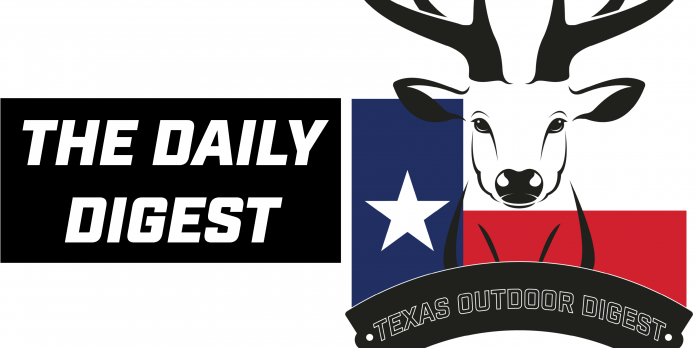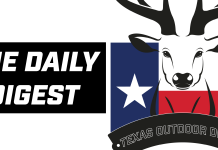The Daily Texas Outdoor Digest is sent to your inbox to keep you up to date about hunting, fishing, conservation and outdoors pursuits making headlines and going viral in the Lone Star State and beyond. It’s free, so subscribe today!
Here’s what’s worth reading today, Monday, September 30, 2019:
Georgia teen shot and killed after his hunting party mistook him for a deer: A 17-year-old hunter in Georgia is dead after he was fatally shot Saturday when his hunting party mistook the teen for a deer, according to police. Bobby Lane, 17, had been hunting in a wooded area near the 500 block of Myers Hill Road in Brunswick, Ga., a semi-coastal region just 35 miles north of the Georgia-Florida border, Glynn County police said in a statement. Lane was in an “area of heavy foliage” when one of his hunting companions, identified as Hector Romero, allegedly thought Lane was a deer and fired. After realizing Lane was shot, the hunting party called police to take him to a hospital, where he was pronounced dead. Family members remembered the 17-year-old as a sportsman who enjoyed being in nature.
On shooting a wild hog: An uneasy hunter brings home the bacon: If there’s a more redneck way to hunt feral hogs, I’m not sure what it is. It started with my dog. Not a hunting dog, mind you. Halifax is a mix between an Alaskan Husky and the Queen of Sheba, so when she requested passage out of doors at 3:30 on a Saturday morning, I stumbled out of bed and humbly acquiesced. My wife and I were visiting my in-laws, who own 40 acres of God’s country west of Fort Worth. Like much of the South, their land has succumbed over the last decade to roaming gangs of wild hogs. I and my keen suburban hunting acumen had been attempting to harvest one for the last few nights, with no success. The herd hadn’t shown itself, but I knew it wasn’t because they were afraid of my skill with a rifle. I’d never hunted anything larger than a bird, and my brief time at the range hadn’t won me any awards. But I was eager to prove to my father-in-law that I could, in fact, bring home the bacon. So, after I opened the back door to let the princess do her business, I forgot about the sleep in my eyes when my ears caught a chorus of squealing, grunting, snorting, and shuffling not 50 yards from the house.
Two people injured in Colorado elk attack captured on video: Two people were injured when a male elk attacked a woman in Estes Park, Colorado, a state parks official said. Video showed a woman thrown to the ground and poked with the bull elk’s antlers, said Jason Clay, a spokesman for Colorado Parks and Wildlife. The Thursday morning attack took place near the town’s visitors center. “She miraculously came out unharmed,” Clay said. “She had some scrapes. She was not transported and did not require medical attention.” A man who is seen on video jumping out of the way slipped and hit his head on a rock but did not make contact with the wild animal, Clay said. The unidentified man was hospitalized in unknown condition.
Arkansas Game & Fish say deer corn could be doing more harm than good: The Arkansas Game & Fish Commission is sending a warning to deer hunters in Arkansas. They say deer corn can be doing more harm than good. In a post related to the upcoming deer season they addressed how some types of deer corn could be the wrong kind of nutrients. They are urging Arkansans’ to think twice before loading up their deer feeders with corn. They suggest improving nutrition for deer and other wildlife by planting things in the ground rather than pouring it out of a bag. Unlike natural food sources, corn does not have enough nutritional value to deer. Also, commercially sold “deer corn” does not meet the requirements as corn sold for livestock or human consumption, said the warning. A post by AGFC said, “In some cases, corn that couldn’t pass inspection for cattle or swine is sold at reduced prices and then bagged and labeled for wildlife. Some of this feed can contain high levels of aflatoxin, a containment derived from fungus on the corn. Deer show less effects from the toxin, but it can wreak havoc on their digestion, causing immunity issues and liver damage.”
Villa Park girl escapes coyote in front yard: A 5-year-old girl managed to escape a coyote that came after her in her family’s Villa Park front yard, and the entire chase was caught on camera. Christine Przybylski had just gone out to check her mailbox for her Halloween costume. Surveillance cameras show a coyote lurking, but Christine doesn’t see it. The costume hadn’t come, so she turns back but doesn’t immediately go back inside. “I decided to go to the swing,” Christine said. “When I went to the swing he run by and I was like, going, and then I was like ‘Oh my god.’ ” The coyote came charging full speed across the front yard, circled the tree, and charged right at Christine. It came so close it touched her.
Fourth Montana hunter attacked by a grizzly bear in 10 days: A fourth hunter in Montana has been injured by a grizzly bear in the last 10 days, marking the most recent attack of its kind in Big Sky country. The fourth victim was injured in the Gravelly Mountains, in the same stretch of wilderness – just eight miles south – of where three hunters were hurt in two separate encounters Sept. 16. According to the outlet, the Ohio man was mauled on Sept. 24 near Coal Creek Drainage and Eureka Basin Road, telling officials that he was ambushed by the bear while walking through blown-down timber. “During the incident, the man reportedly fired multiple shots at the bear until it left. The man was able to meet up with other members of his hunting party and get medical attention,” the Montana Department of Fish, Wildlife and Parks said in a statement.
TPWD reminds hunters about proper deer carcass disposal: The Texas Parks and Wildlife Department reminds hunters throughout the state to properly dispose of carcasses from harvested deer to help prevent the spread of infectious diseases in deer. This is particularly important for those taken inside the Trans-Pecos, South Central and Panhandle Chronic Wasting Disease Containment and Surveillance Zones. “Because many hunters process their own deer, they are key players in preventing environmental contamination or minimizing the spread of diseases such as CWD,” said Alan Cain, TPWD White-tailed Deer Program Leader. “One possible way that disease can spread is by the transportation and improper disposal of infected carcass parts.” Deer can become infected with CWD if they come into contact with other infected deer or an environment contaminated with CWD prions. While CWD prions are found ubiquitously throughout the body of an infected deer, they are known to accumulate in the brain, spinal cord, eyes, spleen and lymph nodes. Additionally, hunters cannot take whole deer carcasses, or carcass parts that contain brain, spinal cord, eyes, spleen, or lymph nodes, out of the CWD Containment and Surveillance Zones or from another state or country known to have CWD.
TPWD taking public comment on proposed regulation changes for trotlines and other related gears: The Texas Parks and Wildlife Department is seeking public comment on proposed changes to the regulations on passive fishing gear (jug lines, minnow traps, perch traps, throwlines, and trotlines), which includes adding requirements and specifications for floats and reducing the valid period for gear tags to reduce the negative impacts of abandoned passive fishing gear in Texas public waters. “Abandoned passive fishing gear is not easily identified and can harm fish and wildlife resources and present a nuisance and safety hazard to recreational users of public water bodies,” said Jarret Barker, TPWD Assistant Commander for Marine Enforcement. “These proposed changes would aid in identifying and monitoring lawful passive fishing gear and help facilitate the removal of abandoned gear.” The proposed changes would require that passive fishing gear have properly marked gear tags and floats attached to aid in distinguishing active fishing gear from abandoned fishing gear and litter. These changes include adding a customer number from a valid fishing license on the gear tag and marking all passive fishing gear with floats that are at least 6 inches in length and not less than 3 inches in width. Floats for recreational anglers can be any color other than orange. Commercial fishing license holders will be required to use orange-colored floats. The changes would also reduce the period of validity for a gear tag from 10 days to four days to shorten the fishing time between angler inspections of their gear.
Stay in the Know With The Daily Texas Outdoor Digest
If you haven’t subscribed yet, there’s no better time than right now (We hate spam and we won’t share your information with anyone. That’s just not cool):




















